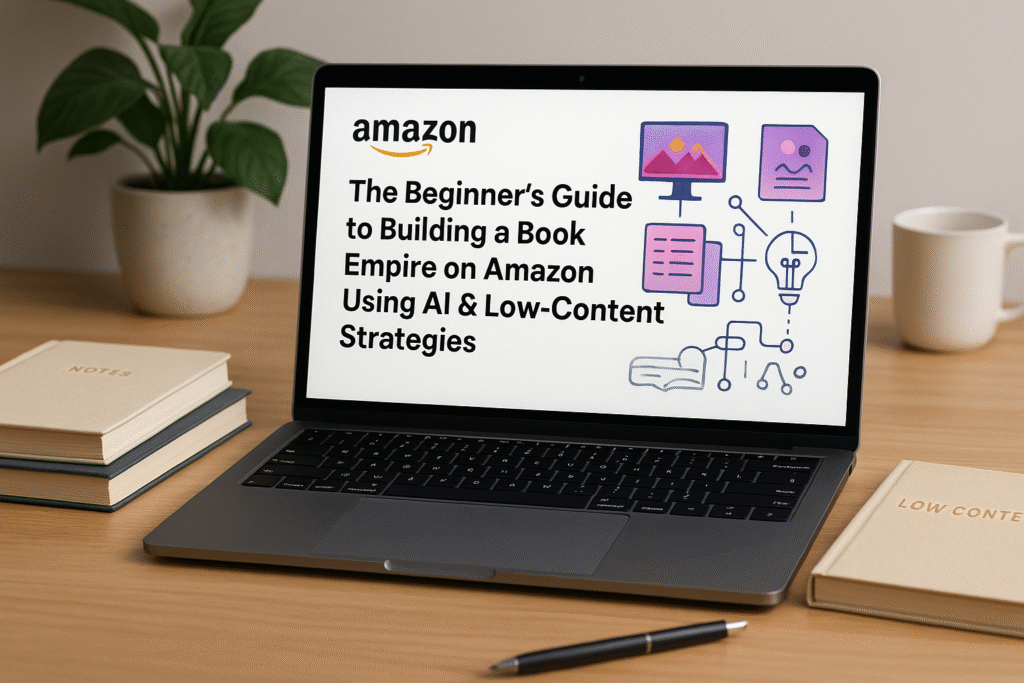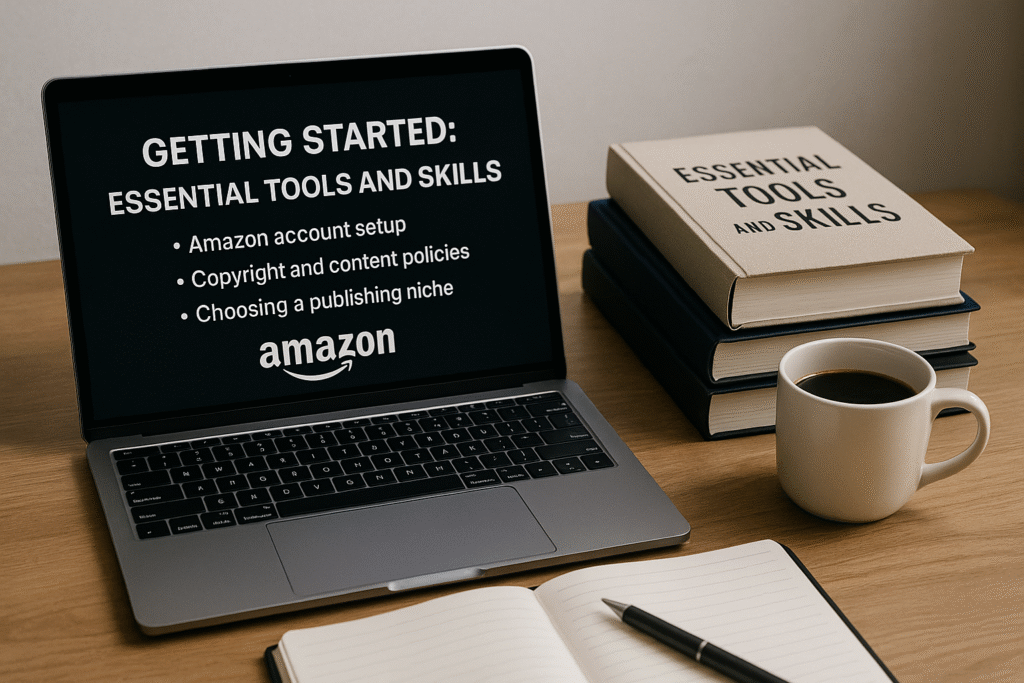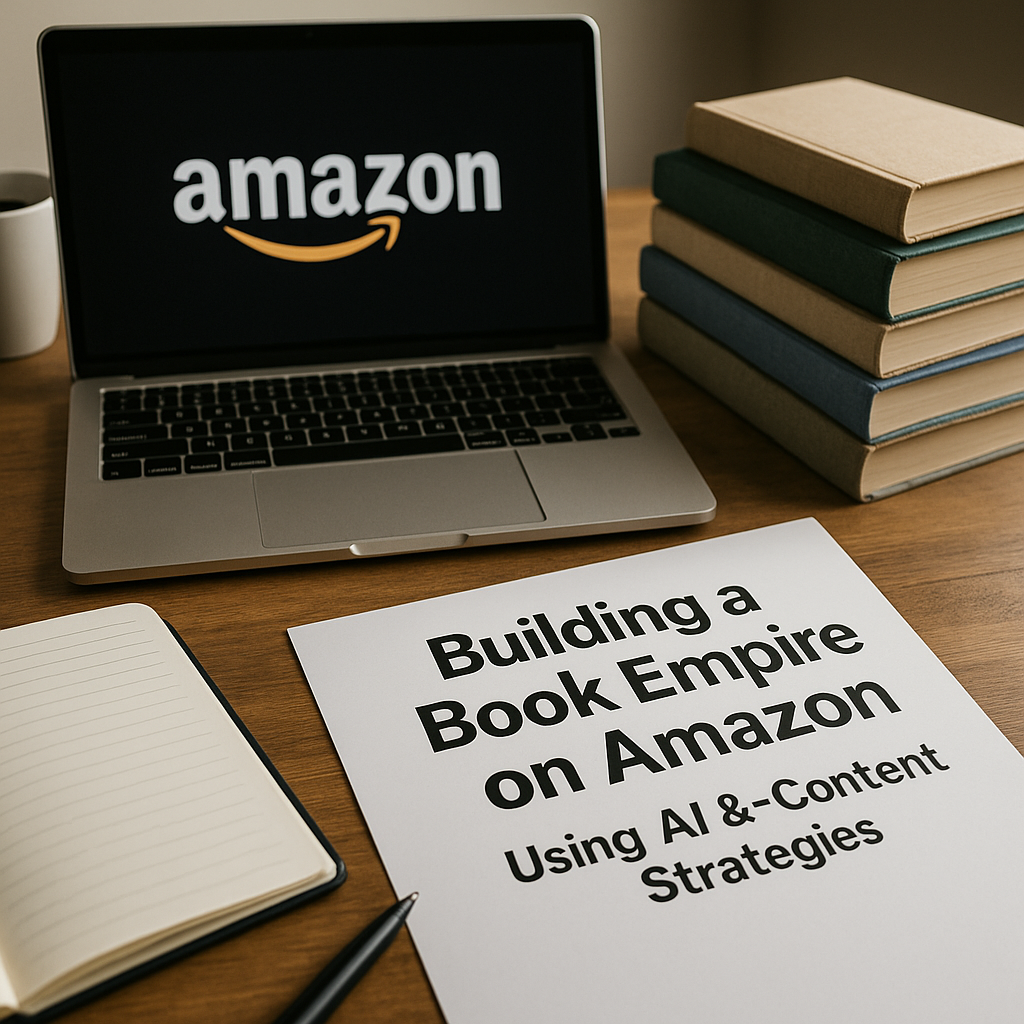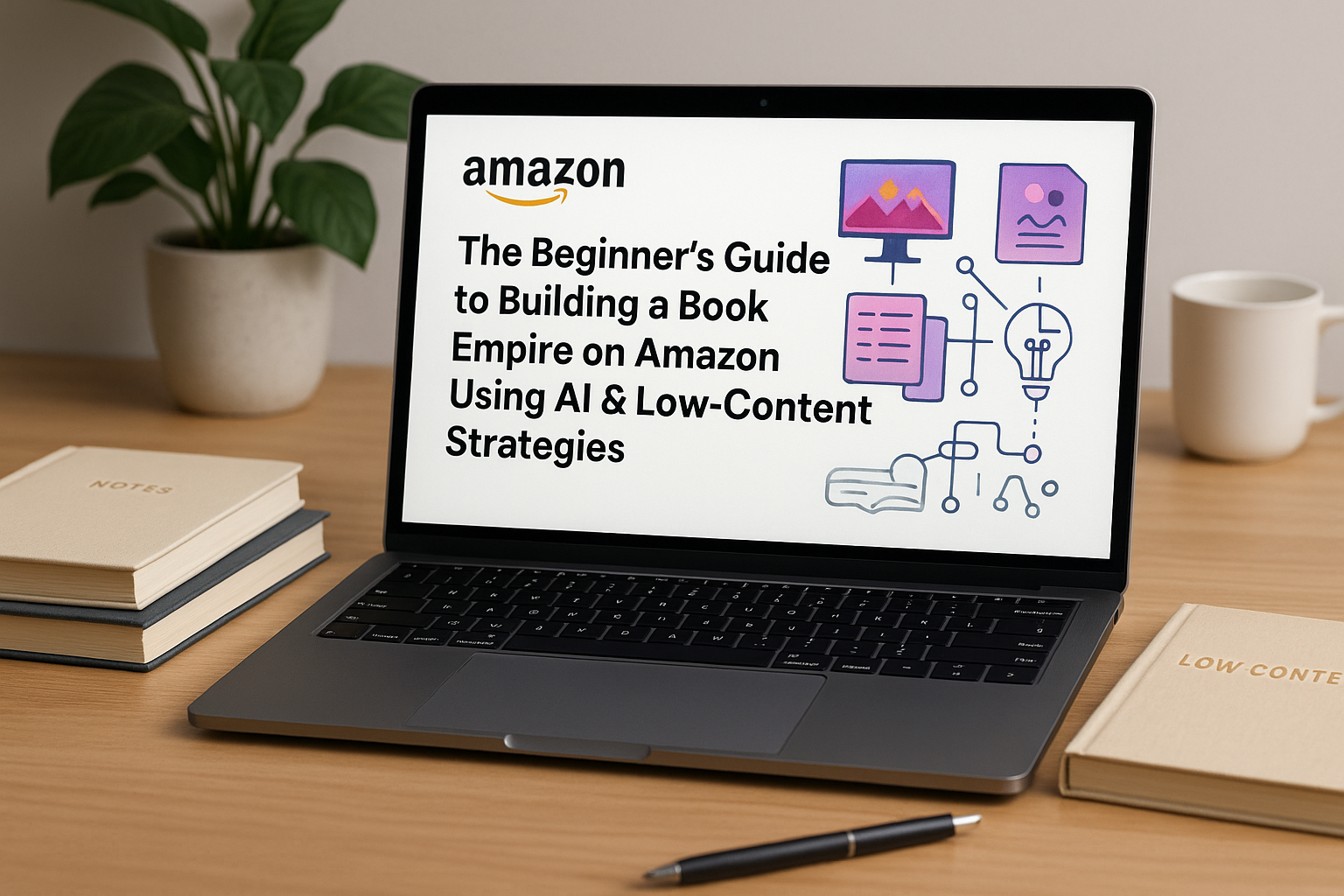Have you ever wanted to make money from books without being an author or expert? I can show you how to build a book business on Amazon by using AI and low-content publishing, step by step. You don’t need to be a writer or designer to get started.
If you’re serious about building a real book business without writing a word, check out the 7-Figure Amazon KDP Playbook I use and recommend. It’s a step-by-step system that changed the game for me.

I’ve learned that with the right tools and a clear system, it’s possible to create and sell notebooks, journals, planners, and more—right from home. By using AI and simple design strategies, I keep the process simple and focused on results.
Key Takeaways
- Learn how to start and grow a book business using Amazon.
- Discover AI and low-content strategies to build a book portfolio.
- Find out how to improve books and increase earnings step by step.
Understanding Amazon KDP and the Book Empire Model

Many people want to sell books online, but they don’t know where to start. I focus on how Amazon KDP works, what a book empire looks like, and the main methods I use to grow sales with low-content and AI tools.
What Is Amazon KDP?
Amazon KDP (Kindle Direct Publishing) is Amazon’s own platform that lets me publish both eBooks and print books. I can sign up, upload books, and start selling within hours. There are no upfront costs; I only pay a part of my sales as Amazon’s commission.
KDP prints books on demand. This means I don’t need to buy or store inventory. When someone orders a book, Amazon prints and ships it for me. I can set my own prices, pick categories, and use keywords so people can find my books easily.
I have complete control over my book listings. KDP lets me track sales and earnings every day through a simple dashboard. It supports various book types, but low-content books (like journals and planners) are especially easy to publish here.
Defining a Book Empire
A book empire on Amazon is a collection of many books that I create and sell to reach as many readers as possible. I don’t just stop at one book. I focus on making dozens, hundreds, or even thousands of titles.
Most of my books are low-content, which means they have simple or repeatable pages. Some examples are:
- Notebooks
- Planners
- Coloring books
- Puzzle books
By building a wide variety of these books, I reach different people who want different styles or themes. This way, I get steady sales from lots of small titles instead of hoping for one bestseller.
Core Strategies for Success
There are a few main strategies I use to build my book empire on Amazon KDP:
- Low-Content Publishing: I create simple books that do not require much writing or editing. These can be designed quickly with templates and basic tools.
- Using AI Tools: I use AI to help generate content ideas, book covers, and even the pages inside my books. This speeds up the process and helps me produce more books in less time.
- Niche Research: I spend time finding specific topics that people want but don’t have many books about. Here is what I look for: Niche Example Why It’s Good Gratitude Journal Many people want to practice gratitude Keto Meal Planner Dieting is always popular Cat Coloring Book Pet lovers buy themed books
- Optimization: I improve my book titles, descriptions, and keywords to ensure my books show up when customers search. I test different covers and formats to find what sells best.
These are the same strategies I learned from the 7-Figure Amazon KDP Playbook. If you want the exact blueprint, you can access it here.
I keep a routine for uploading books regularly and checking my results. This helps me grow my library and find out what works best for my audience.
Getting Started: Essential Tools and Skills

To publish books on Amazon, I need to have the right account set up and follow the rules. Choosing what to publish is important because some topics do better than others.
Setting Up Your Amazon KDP Account
I start by creating an Amazon account, then signing up for Kindle Direct Publishing (KDP) at kdp.amazon.com. The process only takes a few minutes. I need to enter my name, email, and set a password.
Next, I fill in my author information, payment details, and tax info. This lets Amazon send my earnings directly to my bank account. Double-checking my details is important, as mistakes can delay payments.
Here’s what I need:
- Email address for communication
- Bank account for payments
- Tax information for reporting
- Valid ID if Amazon asks to verify my identity
Once I’ve finished, I can access the KDP dashboard to upload and manage my books. I make sure to save my login details in a safe place.
Understanding Copyright and Content Policies
Knowing what I can and cannot publish is key. Amazon has strict rules about using content that I do not own. If I use images, text, or artwork made by someone else, I need permission or a license.
For low-content books (like journals or planners), I must not copy designs from other publishers. I also have to make sure my books do not break Amazon’s guidelines, such as:
- No hate speech
- No copyrighted material without rights
- No misleading or low-quality content
I always read the KDP content guidelines before submitting my work. This helps me avoid having books removed or my account being closed.
Choosing Your Publishing Niche
Picking the right niche can make a big difference in how well my books sell. I look for topics with steady demand and low competition. Low-content books like planners, logbooks, and activity books are popular choices.
To pick a niche:
- Research books on Amazon—look at bestsellers and reviews
- Check search rankings—see if the topic is crowded
- Think about what I know—familiar topics are easier to create
I also use tools like Publisher Rocket or Amazon search suggestions to find ideas. I make a short list, then pick one niche to start. This focus helps me build my book empire step by step.
Leveraging AI for Book Creation

I use AI tools to make book creation easier and faster. With the right tools, I can create book content, design pages, and brainstorm ideas without a huge learning curve.
AI Writing Tools for Book Content
AI writing tools help me quickly write book descriptions, outlines, and even chapter drafts. Programs like ChatGPT and Jasper let me write faster by suggesting sentences, fixing grammar, and helping with writer’s block. For low-content books, such as journals or planners, I use these tools to generate prompts, titles, or daily entries.
Here’s a table showing what common AI writing tools can do:
| Tool Name | Key Feature | Best For |
|---|---|---|
| ChatGPT | Text generation | Book drafts, prompts |
| Jasper | Templates for book content | Descriptions, quick outlines |
| Sudowrite | Creative writing help | Unique stories, copy tweaks |
These tools save me time and let me focus more on the ideas rather than the wording.
Want to see how AI tools fit into a full-scale publishing system? This playbook breaks it all down step by step.
Automating Interior Design with AI
Designing the inside of a book can take a lot of time, but AI makes it easier. Tools like BookBolt and Canva’s Magic Design use AI to create page layouts, fonts, and styles. I can select layouts with just a few clicks, then customize details like headings or journal lines.
For low-content books, I use built-in templates for planners, logs, or notebooks. AI can suggest matching colors, icons, and style elements that fit my book’s theme.
Benefits of using AI for book interiors:
- Consistent design on every page
- Fast creation of clean layouts
- Easy tweaks with drag-and-drop editors
This means I don’t need advanced design skills to make my books look professional.
Using AI for Research and Idea Generation
AI tools also help me brainstorm book ideas and research trends. I use tools like ChatGPT, Bard, or tools built into writing platforms to ask questions, get lists of topics, or check what readers are searching for on Amazon.
For research, I use AI-powered keyword tools to find popular niches or book categories. Some tools also analyze reviews to show what buyers like or dislike.
Examples of AI research tasks:
- Generate a list of daily journal prompts
- Suggest low-content book markets based on Amazon bestsellers
- Summarize customer reviews to find gaps in the market
These steps help me choose better topics and increase the chances that my books will sell.
Low-Content Publishing Strategies

Low-content book publishing lets me create and sell books like journals, planners, and notebooks without having to write a lot. With the right design and content choices, I can reach different audiences and build my brand.
Types of Low-Content Books
Low-content books are books with little or no written content. Some common examples include:
- Journals: Lined, blank, or prompted for notes or daily writing
- Planners: Daily, weekly, or monthly planning pages
- Notebooks: Simple lined or graph paper notebooks
- Logbooks: For tracking habits, expenses, nutrition, fitness, or mileage
- Coloring books: Line drawings for coloring
- Puzzle books: Crosswords, sudoku, word searches
Here is a comparison of some types:
| Type | Main Features | Popular Audience |
|---|---|---|
| Journals | Lined or prompted pages | Students, adults |
| Planners | Calendars, to-do lists | Professionals, parents |
| Logbooks | Trackers, logs | Fitness fans, drivers |
| Coloring | Artwork to color | Kids, adults |
When I select a type, I focus on who will use the book and what problem it will help them solve.
Design Principles for Low-Content Books
Simple design makes a big difference in low-content books. I use clear fonts, easy-to-read layouts, and enough white space so pages don’t look crowded.
A good cover is important. I keep covers bold and focused, matching the style to the book’s purpose. For example, a planner cover might use calm or professional colors, while a coloring book might be more colorful.
I also make sure my designs follow Amazon’s guidelines for size, bleed, and format. Using templates can save me time and keep designs consistent.
Pros and Cons of Low-Content Publishing
Low-content publishing has several benefits. I can make books fast and test different ideas without writing much. The startup costs are low, since I don’t need to hire writers or spend weeks drafting content.
However, there are downsides. Competition is high, so it can be hard to stand out unless I find a well-defined niche or bring a fresh design. Also, because the content is simple, some books may have lower value in the eyes of buyers.
I balance these points by focusing on quality design and unique topics, which can help my books get noticed and sell more often.
Creating High-Quality Book Covers and Interiors

Book covers and interiors are often the first things buyers notice. I focus on both visual appeal and clear layouts to help my books attract readers and provide a good user experience.
AI-Powered Cover Design Tools
I use AI design tools like Canva, Book Bolt, or Adobe Express to create sharp and modern book covers. These tools let me choose from ready-made templates, drag-and-drop images, and adjust fonts easily. They also suggest color combinations and layout ideas, which helps save time.
To make my covers pop, I select images and icons that match the book’s theme. For example, I add playful shapes for children’s activity books or elegant fonts for journals. I follow Amazon’s cover size rules, usually 6×9 inches for paperbacks, and export covers in high-resolution PDF or JPG.
| Tool | Key Feature | Website |
|---|---|---|
| Canva | Drag-and-drop UI | canva.com |
| Book Bolt | KDP templates | bookbolt.io |
| Adobe Express | AI art options | adobe.com/express |
Optimizing Visuals for Your Audience
I pick styles and graphics that fit what my audience wants and expects. For kids, I use bright colors and simple, clear pictures. For planners or adult coloring books, I stick to calm colors and clean lines.
Every page must be easy to read. For lined journals, I make sure the lines are spaced enough for handwriting. If I add prompts or activities, I check that the text is large and readable. I test covers and interior pages by printing samples or creating digital previews, so I can catch mistakes before publishing.
Optimizing Book Listings for Maximum Visibility

Gaining attention on Amazon takes more than just uploading a book. I focus on keywords, descriptions, and pricing to make books stand out and reach the right readers.
Keyword Research and Implementation
To get my book noticed, I start with keyword research. I use tools like Amazon’s autocomplete, Book Bolt, and Publisher Rocket. These help me find phrases that readers actually type when searching for books.
Once I have my keywords, I use them in my title, subtitle, and backend keywords. I don’t overstuff—a few high-traffic, relevant keywords are better than a list of random words. Here are good places to insert keywords:
- Book Title
- Subtitle
- Book Description
- Seven Backend Keyword Slots
I check what similar books use as keywords for more ideas. Using accurate, targeted keywords brings in buyers who are looking for exactly what I offer.
Crafting Compelling Book Descriptions
A strong description helps my book get chosen over others. I write in short, clear sentences. I highlight the benefits and the main purpose of the book early on.
I break the text into small paragraphs or bulleted lists, so it’s easy to read. I use bold or italic text to point out important features, like:
- Number of pages
- Type of content inside
- For whom the book is best suited
Sample bullet points:
- Easy-to-use layout
- Perfect for kids ages 4-7
- Great for travel or quiet time
I avoid making unsupported claims. Instead, I stick to real features and benefits that can be verified by buyers after purchase.
Strategic Pricing Approaches
Setting the right price is important. I check what similar books charge by searching in my category and noting their price range in a table:
| Book Type | Average Price |
|---|---|
| Coloring Book | $5.99 |
| Journal | $6.49 |
| Puzzle Book | $7.99 |
For new books, I sometimes start slightly lower than the average to attract buyers and get reviews. Later, I adjust my price based on sales and competition.
I take into account printing costs before setting a final price to ensure I still make a profit. I review my prices every few months to stay competitive as the market changes.
Marketing and Growing Your Book Portfolio

Putting books on Amazon is just the start. I need to attract buyers and keep them coming back to my collection.
Building an Author Brand on Amazon
My author brand helps readers recognize my work and trust the quality. I make sure my author name, profile photo, and bio are clear and professional. I use the same name and style across all my books for consistency.
I write a short, honest description for each book so people know what to expect. Reviews are important, so I encourage buyers to leave honest feedback. I’m careful to answer questions and reply to comments on my author page.
I update my author page with new releases and special offers. This helps readers see that I’m active and serious about my book business.
Leveraging Social Media and Online Communities
I use social media to share my books and connect with potential readers. Platforms like Instagram, Facebook, and TikTok are good for posting book photos, behind-the-scenes content, and new release announcements. I keep my posts simple and use hashtags that fit my book topics.
I join groups and forums where people talk about the types of books I create, like planners or journals. Being helpful and sharing tips in these groups can build trust without over-promoting. Sometimes I offer free sample pages or short discounts to encourage new readers to try my books.
I track which posts or groups bring the most attention so I can focus my efforts where they work best. I reply to questions and engage with comments to show that I value the community.
Scaling Your Book Empire with Automation

To grow my book business beyond a few titles, I need to save time and manage more tasks with less effort. Automation and smart delegation can help me handle bigger projects and increase my profits.
Automating Book Production Workflows
I use special tools to speed up each step of book production. These include software for formatting manuscripts, designing covers, and scheduling uploads to Amazon. For example:
- Book Formatting: I use tools like Atticus, Vellum, or Reedsy to quickly format manuscripts for both print and digital editions.
- Cover Design: Services like Canva and BookBolt help me make professional covers fast.
- Uploading: Amazon’s KDP dashboard can process bulk uploads, and some automation tools can handle metadata and pricing updates.
Here is a quick table of helpful automation software:
| Task | Tool Example | Benefit |
|---|---|---|
| Formatting | Atticus, Vellum | Faster book layout |
| Cover Design | Canva, BookBolt | Quick, stylish covers |
| Bulk Uploading | KDP, BookBolt | Less manual data entry |
By automating repeat steps, I can publish more books with fewer mistakes.
Outsourcing and Delegation Strategies
When I need to handle more books than I can manage alone, I hire help for certain tasks. Common jobs to outsource include cover design, editing, keyword research, and description writing.
I usually find freelancers on sites like Upwork, Fiverr, or Freelancer.com. I give specific instructions and templates to keep quality high. I track spending to make sure each book stays within budget. Here’s what I commonly delegate:
- Covers and formatting: Skilled designers and formatters
- Proofreading: Professional editors
- Listings: Virtual assistants for research and uploads
Tip: I always check samples and reviews to find good freelancers. Delegation frees up my time so I can focus on planning new titles and growing sales.
Tracking Performance and Continuous Improvement

I always want to know how my books are performing and what I can do better next time. Using data and feedback helps me adjust my products and improve my Amazon sales over time.
Analyzing Sales Data and Trends
I rely on sales data to understand what sells and what doesn’t. Tools like Amazon KDP Reports and third-party analytics show me how many books I sell each day, week, and month. I watch for sharp jumps or drops in sales so I can spot patterns.
I track which cover styles, niches, or titles do best. I also compare performance during holidays or special events. To keep things organized, I use simple tables:
| Book Title | Month | Sales | Reviews |
|---|---|---|---|
| Daily Planner | April | 40 | 7 |
| Kids Journal | April | 15 | 2 |
By looking at data like this, I can make important decisions about what to create next or which books to advertise more.
Iterative Product Development
After checking sales data, I use it to guide updates. For example, if a certain interior or cover design gets more sales, I focus on that style for future books. If one product has bad reviews, I read the comments to find problems I can fix.
Sometimes, even small changes can make a difference. I might try a new subtitle, fix a typo, or update keywords. I also test new ideas in small batches first. This way, I know if changes are working before making bigger updates.
I always keep a list of feedback and ideas, then plan which improvements to try next based on what matters most to buyers.
Mitigating Risks and Navigating Challenges
When starting out, I know it’s important to be aware of common risks. These include copyright issues, poor book quality, and low sales. I always make sure any content I use or create—whether with AI or by hand—is original and not copied.
I follow Amazon’s rules to avoid having my listings removed or my account suspended. Reading Amazon’s content guidelines helps me stay on the right side of their policies.
To handle quality concerns, I review my book files and covers before uploading. I check for spelling mistakes and unclear images. If I get feedback or negative reviews, I take them seriously and improve my next book.
Here’s a quick table showing some challenges and how I address them:
| Challenge | What I Do |
|---|---|
| Copyright Problems | Use original text and images |
| Poor Book Formatting | Preview books before publishing |
| Low Visibility | Use keywords and good descriptions |
| Bad Reviews | Learn and improve from feedback |
I also keep a backup of my files in case there are account problems. Staying organized helps me recover faster if anything goes wrong.
Staying updated on Amazon policy changes is an important habit. When I notice a rule change, I adjust my process as soon as possible.
If you’re ready to build your own book empire, this is the system I recommend. It’s helped thousands of creators publish smarter and earn more with Amazon KDP.
Final Thoughts and Next Steps
I’ve shared how to use AI and low-content strategies to build books for Amazon. Now, I want to lay out some steps you can take right away.
Here’s what I suggest:
- Choose your book niche.
- Pick your tools—AI writing, design software, and Amazon KDP.
- Start small with one book to learn the process.
If you feel stuck, try making a simple notebook or journal. You don’t need much to start. Even a blank lined book can let you practice uploading and formatting.
I keep track of my ideas in a table like this:
| Idea | Type | Notes |
|---|---|---|
| Daily Planner | Low-Content | Dated pages |
| Coloring Book | Low-Content | Animal themes |
| Gratitude List | No Content | Simple layout |
It’s helpful to focus on learning and adjusting as you go. I test new book ideas and watch for what sells best.
Simple action steps:
- Make your first book.
- Upload it to Amazon.
- Review your listing.
- Learn from results.
I aim to be patient with myself. Success builds step by step as I keep trying and improving my books.
And if you want a proven shortcut instead of figuring it out alone, get the 7-Figure Amazon KDP Playbook here.

Leave a Reply